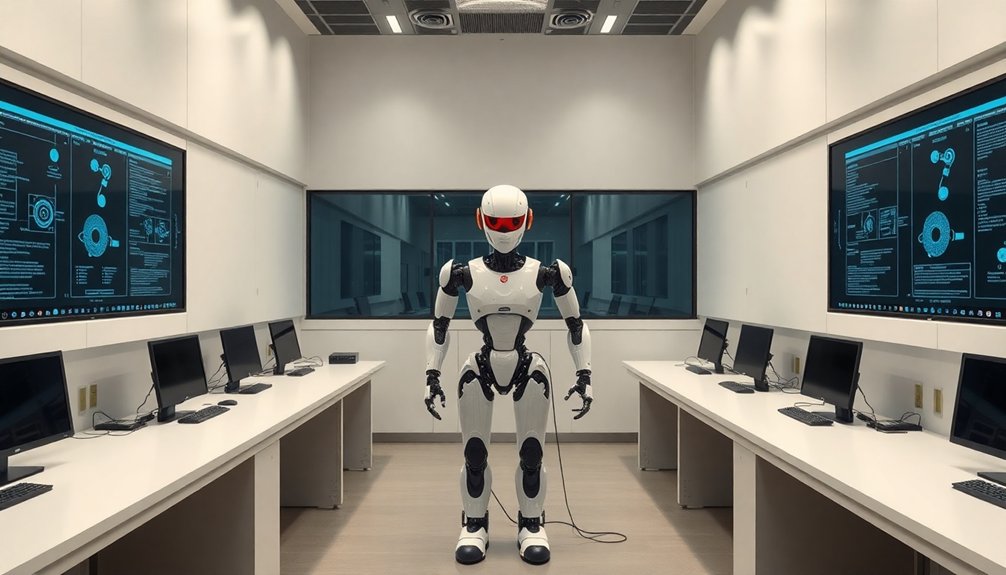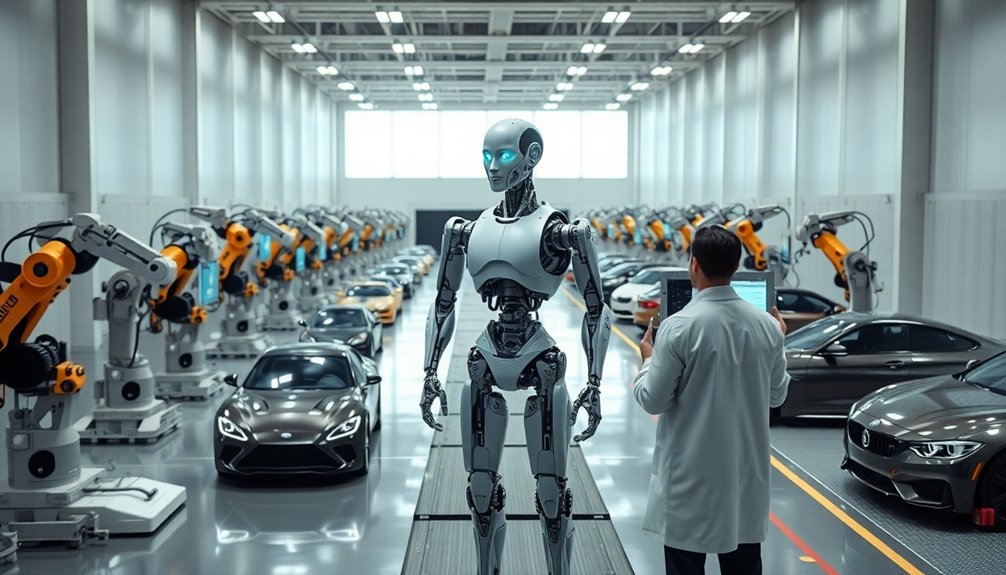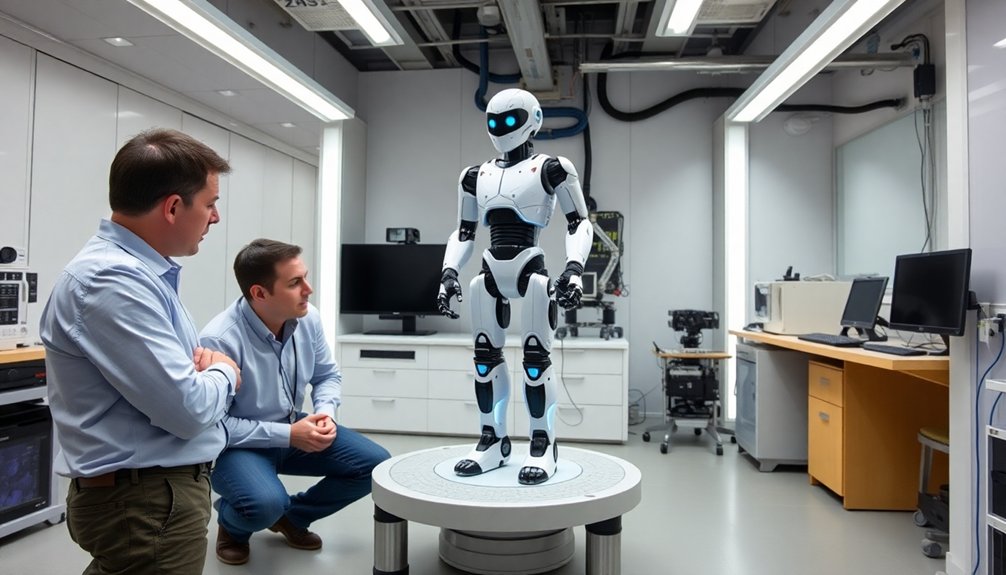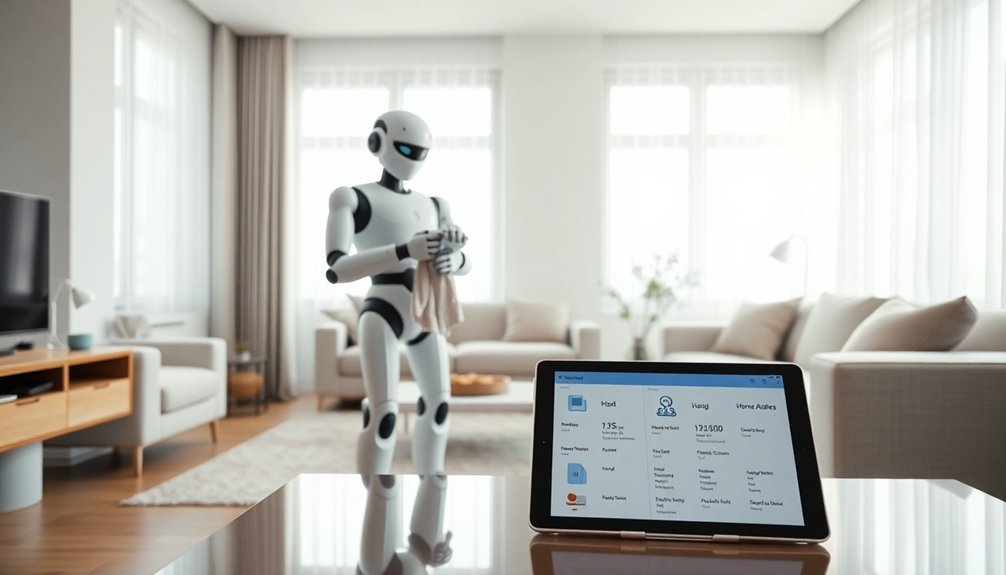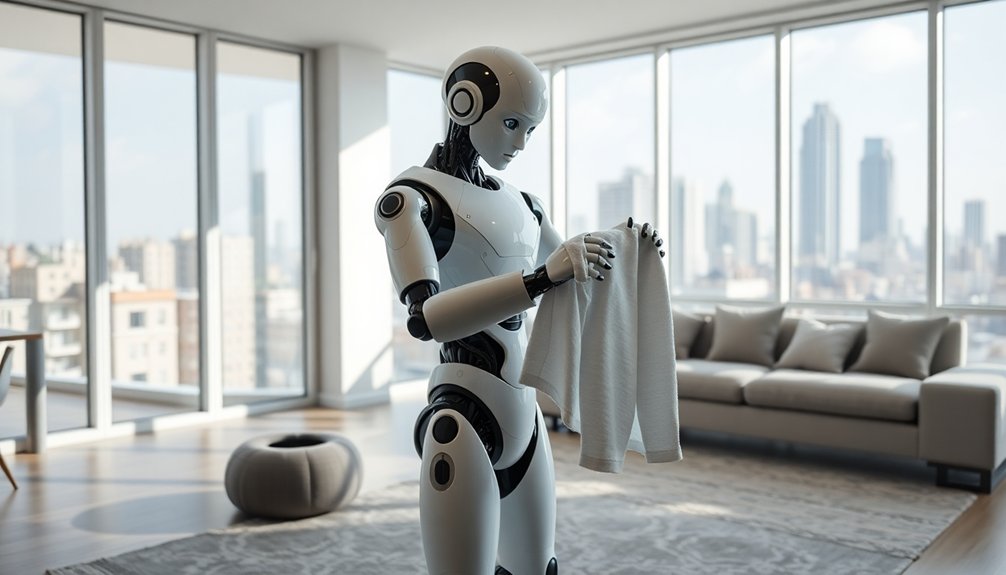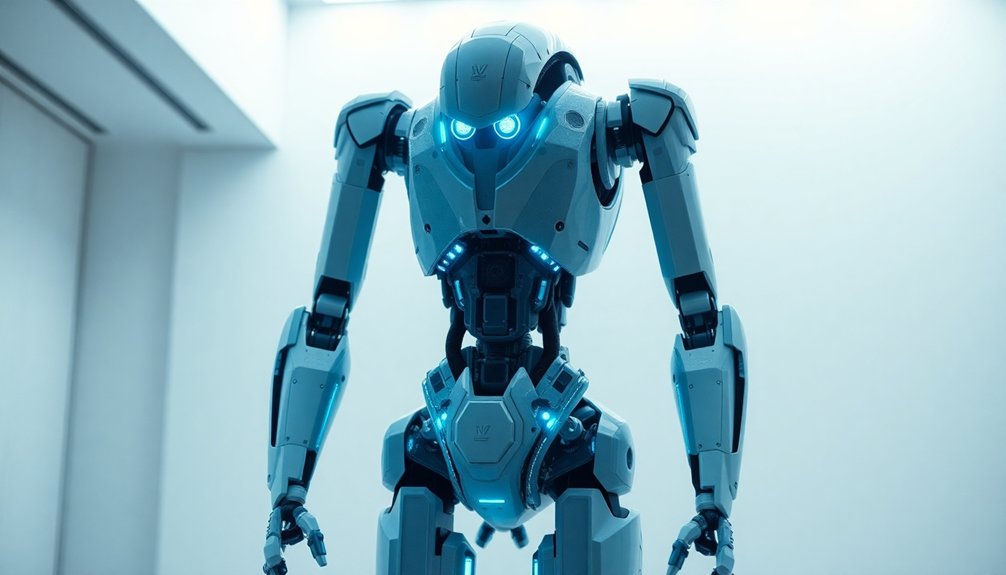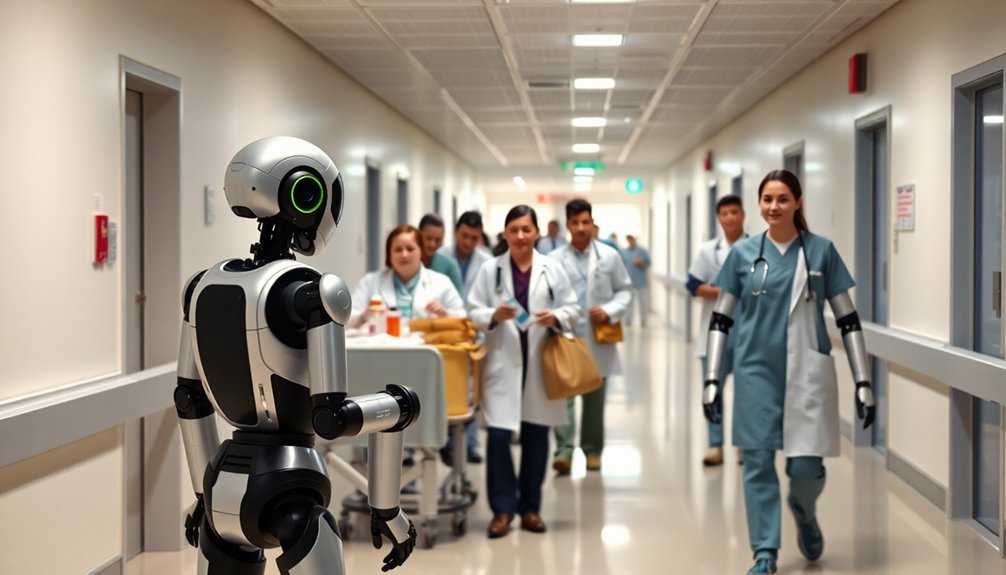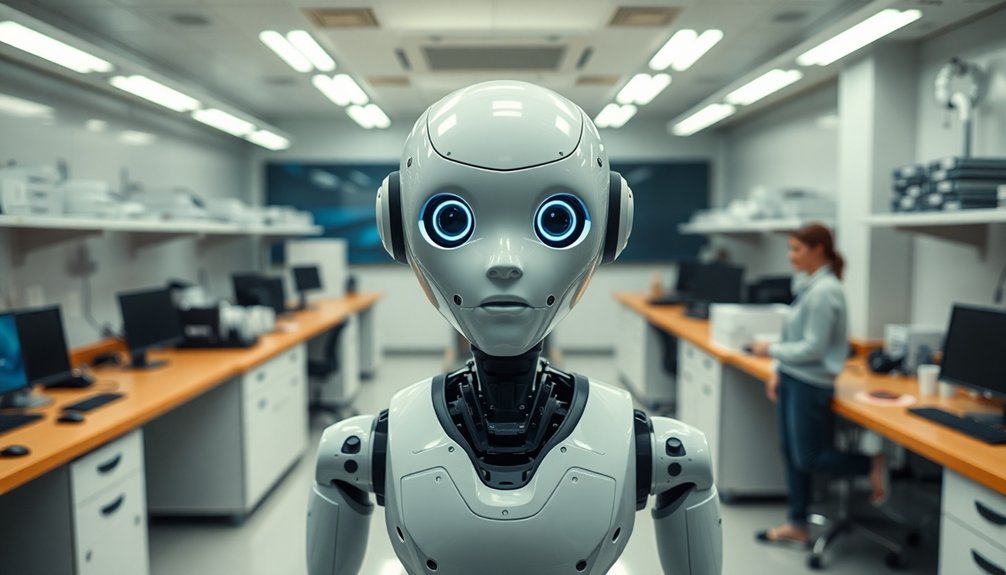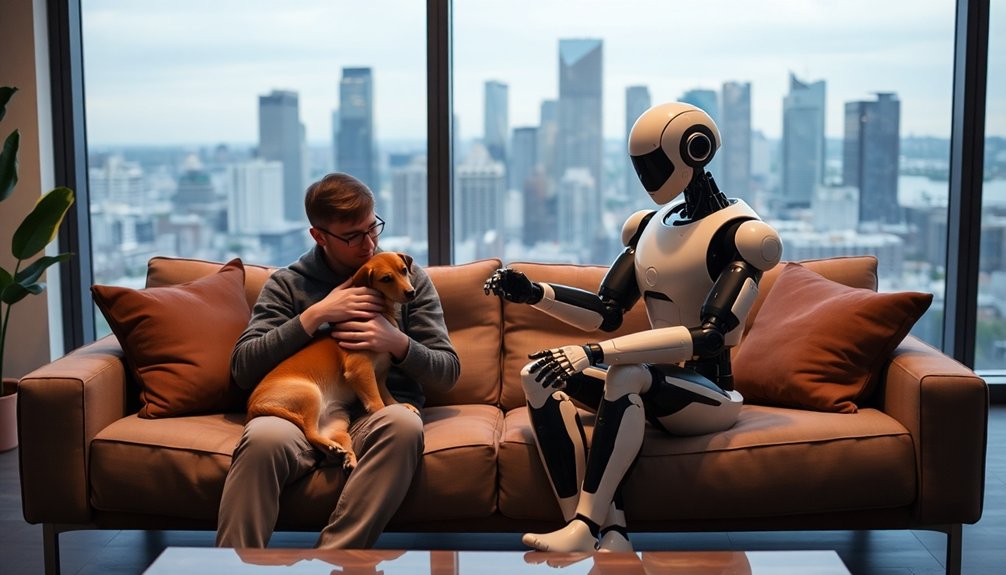ROS is like the Swiss Army knife of robot brains, while custom AI platforms are more like expensive, single-purpose tools. We’ve watched ROS democratize robotics, offering modular, cost-effective solutions that let developers swap components like Lego pieces. Custom platforms promise fancy performance but often cost a small fortune. The future? Hybrid systems that blend open-source flexibility with targeted AI capabilities. Curious about the robot revolution? Stick around.
The Evolution of Robotic Operating Systems
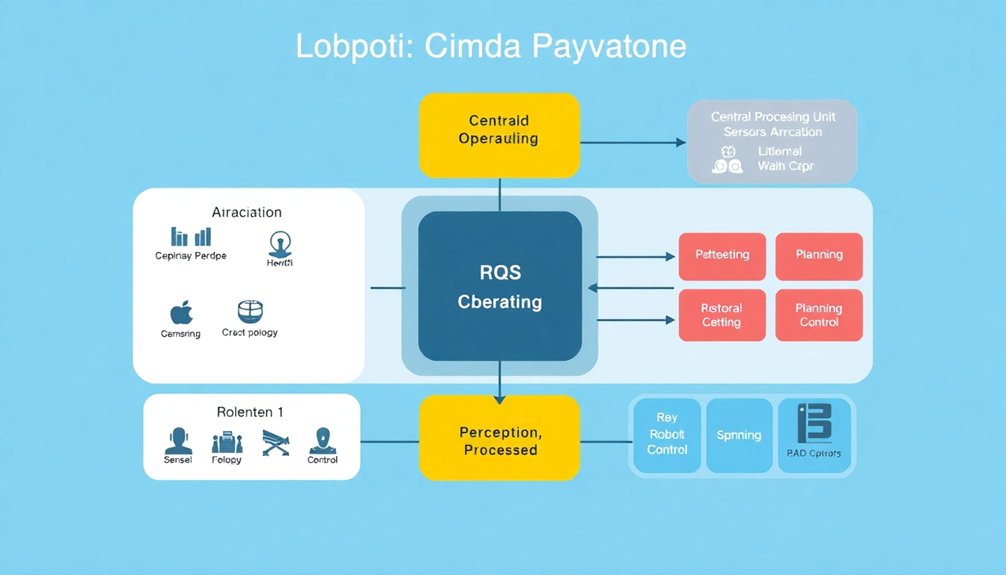
When robots first crawled out of laboratory test beds, nobody could’ve predicted how quickly they’d transform from clunky metal experiments to sophisticated digital companions. Stanford’s robotics pioneers strategically developed ROS as a unified communication protocol, enabling disparate robotic systems to share computational resources and algorithmic intelligence. Our robot evolution story isn’t just about hardware—it’s about software interoperability that lets these mechanical marvels communicate and learn. The Robot Operating System (ROS) became the breakthrough, turning isolated robotic platforms into collaborative networks that could share code, sensors, and intelligence. Global robotics research demonstrated that ROS emerged as a critical milestone in 2009, providing an open-source framework that accelerated robot software development across multiple domains. Sensor fusion techniques enabled robots to integrate multiple data streams, dramatically enhancing their perception and adaptive capabilities.
From Stanford’s early reasoning robots to Willow Garage’s open-source vision, ROS transformed how we design and deploy robotic systems. It’s like giving robots a universal language, allowing them to swap skills and knowledge as easily as we share gossip.
Who would’ve thought lines of code could make machines talk to each other so seamlessly?
Core Architecture of Robot Platforms
Although robot architectures might sound like a complex maze of wires and algorithms, they’re really just sophisticated digital playgrounds where machines learn to think and move.
Robot architectures: intricate digital universes where wires and code dance, transforming machines into thinking, moving marvels.
We design these platforms around hardware modularity and software interoperability, which basically means building robots like epic digital Lego sets. AprilTag navigation provides a precise visual tracking mechanism that enhances robotic positioning and movement capabilities. Collaborative research guidelines suggest that systematic architecture documentation is crucial for creating robust and maintainable robotic systems. Soft robotic technologies are revolutionizing our approach to creating more responsive and adaptable humanoid robot platforms.
Think of it like a robotic buffet where you can grab a sensor here, a motor there, and create something totally unique.
The magic happens in how these pieces communicate – through distributed networks that let nodes (aka robot brain segments) chat seamlessly. It’s not just about building machines; it’s about creating intelligent systems that can adapt, learn, and potentially outsmart their creators.
Wild, right?
Performance Benchmarks: ROS Vs Custom Solutions
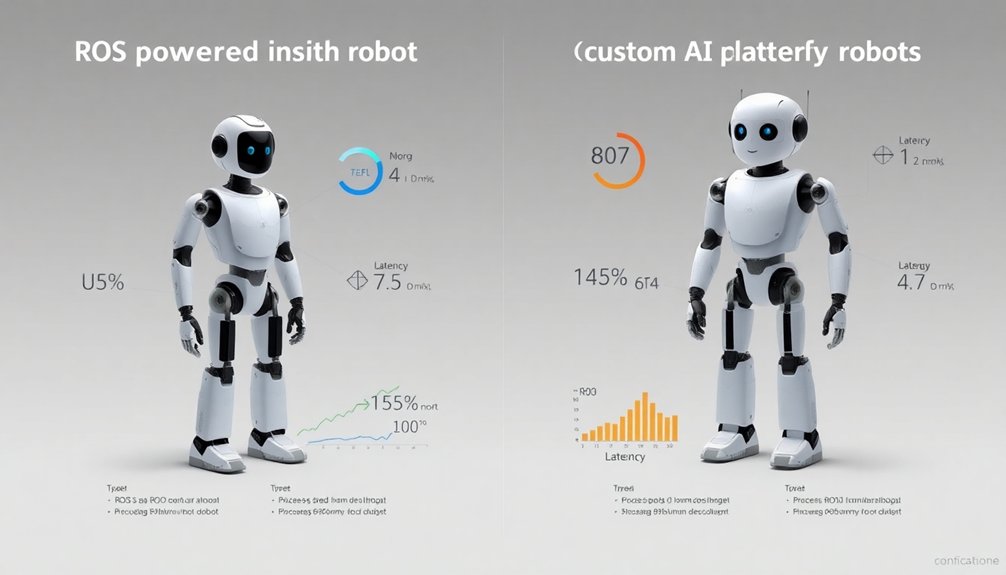
We’re about to map out how robot brains genuinely perform under pressure, comparing the open-source ROS ecosystem against custom-built AI platforms in a no-holds-barred performance showdown.
Processing speed isn’t just about raw numbers — it’s about how quickly a robotic system can sense, decide, and act in milliseconds that could mean the difference between a smooth navigation and an embarrassing face-first tumble. Neural network optimization allows robotic systems to process complex environmental data at unprecedented speeds.
Our benchmarks will expose how different robot operating systems handle real-time challenges, revealing whether the flexibility of ROS can genuinely compete with purpose-built AI platforms designed for lightning-fast, mission-critical responses. The Isaac ROS benchmarks demonstrate that open-source platforms can achieve impressive performance metrics across complex robotic tasks. CloudMinds’ cloud brain platform HARIX provides a sophisticated integration framework that could dramatically influence these computational performance evaluations.
Processing Speed Test
Processing speed isn’t just a nerdy metric—it’s the heartbeat of robotic intelligence, and the battle between ROS and custom solutions reads like a high-stakes tech showdown. ROS 2 Benchmark demonstrates that performance measurement tools can objectively quantify computational efficiency across different robotic platforms.
We’ve seen how custom platforms can turbocharge processing techniques with targeted optimization strategies, leveraging hardware like NVIDIA GPUs to outpace traditional ROS frameworks. Humanoid robot sensors play a critical role in translating these computational advances into real-world adaptive intelligence. Apex.Grace demonstrates that embedded system optimization can bridge the gap between prototype flexibility and production-grade performance.
Think of it like swapping a bicycle engine for a rocket booster—suddenly, your robot isn’t just moving, it’s flying.
ROS might offer flexibility, but custom solutions bring raw computational muscle that can transform sluggish algorithms into lightning-fast decision engines.
We’re talking millisecond differences that could mean life or death in critical robotic applications.
The future isn’t about which platform wins, but how smartly we can push computational boundaries.
Real-Time Response Metrics
How fast can a robot think? We’re obsessed with measuring robot brain speed through latency measurement and message handling precision. Check out this quick performance snapshot:
| Metric | ROS | Custom Platform |
|---|---|---|
| Latency | Standardized | Highly Customizable |
| Throughput | Consistent | Potentially Faster |
| Scalability | Moderate | Advanced |
Real-time response isn’t just about raw speed—it’s about intelligent reaction. Workforce transformation strategies suggest that the evolution of robotic systems mirrors broader technological adaptation trends. Our robotic systems now measure everything from system reaction time to execution latency with scientific precision. ROS offers solid, predictable performance, while custom AI platforms promise breakthrough responsiveness. The catch? Custom solutions demand more development sweat. CVNode Manager enables advanced performance monitoring of interconnected robotic algorithms across different computational nodes.
We’re talking milliseconds that can mean the difference between a robot gracefully catching a falling object or watching it crash. Performance isn’t just numbers—it’s the split-second dance of technological reflexes. Performance metrics like latency and throughput are crucial in determining the effectiveness of robotic systems, providing critical insights into their real-world capabilities.
Resource Utilization Comparison
Speed isn’t everything—robot performance hinges on how smartly machines manage their digital muscles and neural networks. When we compare ROS and custom AI platforms, resource efficiency becomes the real game-changer.
Think of it like training an athlete: every gram of unnecessary weight slows performance. Custom platforms strip down middleware, targeting specific hardware like precision instruments. ROS offers flexibility but often at the cost of added computational overhead.
Our optimization strategies reveal that tailored solutions can dramatically reduce energy consumption and CPU usage. Why run a marathon in heavy boots when you can wear racing flats?
Hardware Integration and Compatibility
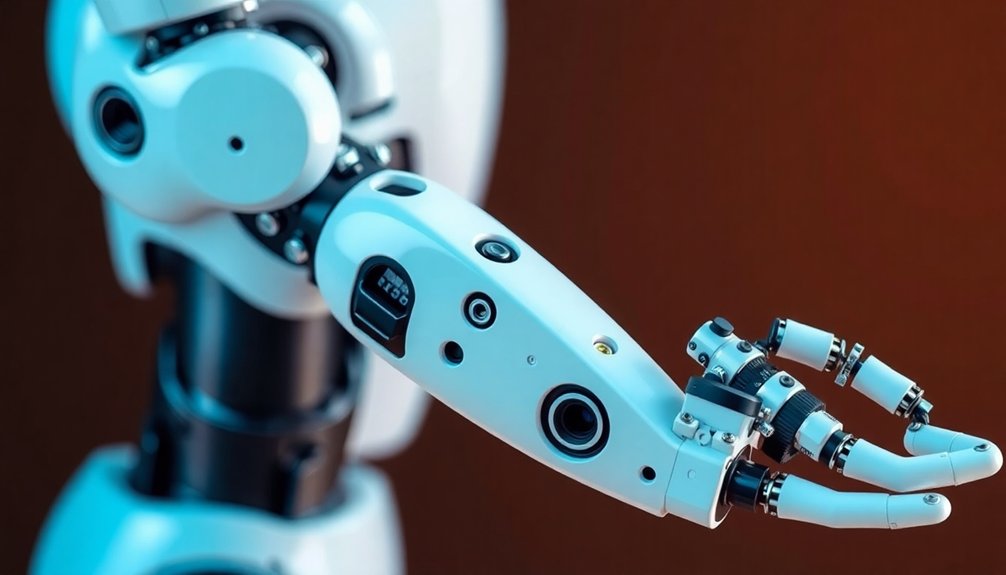
When it comes to building humanoid robots that don’t fall apart like a toddler’s Lego project, hardware integration is where the real magic (and mayhem) happens.
We’ve learned that integration challenges aren’t for the faint of heart. Hardware standardization becomes critical, with compatibility testing separating the pros from the amateurs. Custom platforms demand serious customization strategies, while ROS offers a more modular design that lets developers breathe easier.
Think of it like robot Jenga: every component must click perfectly without toppling the entire system.
Robot engineering is precision choreography: one misaligned piece and the whole mechanical dance crashes down.
Our approach? Focus on standardized interfaces, prioritize flexible architectures, and never underestimate the power of smart design. Custom platforms might offer killer performance, but they’ll cost you more sweat and tears.
ROS? It’s like having a Swiss Army knife for robot building — versatile, reliable, and surprisingly elegant.
Open-Source Dynamics in Robotics Development
We’re living in an era where open-source robotics isn’t just a nerdy hobby—it’s a global collaboration that’s rewriting how we build intelligent machines.
Imagine a worldwide network of engineers, researchers, and tinkerers sharing code, data, and crazy ideas, turning complex robotic challenges into community problem-solving adventures. By breaking down proprietary barriers and creating shared platforms like Space ROS and ARES, we’re not just developing robots; we’re democratizing the future of technological innovation.
Open Source Collaborations
Because robotics is evolving faster than a caffeine-fueled programmer can debug code, open-source collaborations have become the secret sauce transforming how we develop humanoid systems. We’re seeing incredible momentum in collaborative projects where institutions share dataset contributions that push boundaries.
| Platform | Key Advantage |
|---|---|
| ROS | Seamless Integration |
| NVIDIA Isaac | Synthetic Data Gen |
| Open X-Embodiment | Multi-Lab Trajectories |
| Fourier ActionNet | Humanoid Research |
| AgiBot World | Manipulation Benchmarks |
Our secret weapon? Collective intelligence. By pooling resources, we’re cracking complex robotic challenges that would’ve seemed impossible just years ago. Imagine hundreds of brilliant minds working simultaneously, each contributing a piece to the massive humanoid robot puzzle. It’s not just collaboration—it’s a global brain trust accelerating technological evolution at warp speed.
Community Knowledge Sharing
Since the dawn of robotics, knowledge has been a closed-circuit system—until now.
We’re witnessing a radical transformation in how developers share insights. ROS has cracked open the vault of robotic intelligence through open-source meetups and developer workshops that turn isolated brilliance into collective genius. Nine thousand-plus research citations prove this isn’t just talk—it’s a revolution.
By leveraging platforms like ROS Discourse and Robotics Stack Exchange, engineers aren’t just building robots; they’re building a global brain trust. Imagine collaborative nodes where a programmer in São Paulo can debug code with a researcher in Tokyo, all within minutes.
These aren’t just knowledge-sharing tools—they’re quantum leaps in collective problem-solving. And the best part? We’re just getting started.
Technological Innovation Networks
The collective genius of robot builders isn’t just about code—it’s about connection. In collaborative ecosystems like ROS, innovation incentives drive rapid technological evolution. We’re witnessing a revolution where open-source platforms transform how robots are built, shared, and reimagined.
- ROS 2 breaks traditional barriers, offering cross-platform compatibility that lets developers collaborate globally.
- Community-driven development means faster iterations and more robust solutions.
- Open standards create a playground where creativity meets technical precision.
Think of it like a global hackathon where every developer brings their unique skills. ROS isn’t just software; it’s a movement.
AI and Machine Learning Integration Strategies
When we plunge into AI and machine learning integration strategies for humanoid robots, we’re fundamentally mapping out the neural pathways connecting silicon brains to mechanical limbs.
Our AI integration techniques aren’t just about coding—they’re about creating symbiotic relationships between algorithms and actuators.
Machine learning optimization means crafting models that can learn, adapt, and respond in real-time, transforming rigid robotics into fluid, intelligent systems.
We leverage ROS and custom platforms to build modular architectures that can handle everything from image processing to complex movement primitives.
It’s like teaching a robot not just to walk, but to dance—with precision, creativity, and a hint of personality.
The future isn’t about replacing humans; it’s about collaborating in ways we’ve never imagined.
Real-Time Processing and System Optimization

While most tech conversations about robotics sound like dry academic papers, real-time processing is where the magic actually happens.
We’re talking about millisecond-level precision that transforms robots from clunky machines to lightning-fast decision makers. Real-time optimization isn’t just a neat trick—it’s the difference between a robot that responds and one that predicts.
Key real-time processing insights:
- Resource management determines a robot’s responsiveness, acting like its neural network’s reflexes.
- Deterministic execution means removing unpredictability, creating machines that think faster than humans.
- Custom platforms offer surgical precision in timing and hardware interaction.
Our approach? Build systems that don’t just compute, but compute with purpose.
We’re creating robots that can think, react, and adapt in microseconds—turning science fiction into everyday reality.
Cost and Development Complexity Analysis
When it comes to building humanoid robots, we’ve learned that your wallet’s going to take a serious hit — custom AI platforms can cost up to half a million bucks, while open-source systems like ROS give you a more budget-friendly path.
We’re talking about development strategies that balance cutting-edge technology with fiscal sanity, where every line of code and hardware component represents a calculated investment in the robotics frontier.
Our exploration of development time expenses and resource allocation isn’t just about numbers, it’s about understanding how smart technology choices today shape the robotic ecosystems of tomorrow.
Development Time Expenses
Three major factors drive the development time expenses in humanoid robotics: complexity, cost, and community support.
When comparing ROS to custom AI platforms, we see clear development speed advantages that can’t be ignored.
- Custom platform challenges often include higher initial costs and more complex integration processes.
- ROS provides standardized tools that dramatically reduce time-to-market.
- Community resources can cut development expenses by up to 40%.
We’ve watched countless robotics teams waste precious resources reinventing wheels when robust, pre-built solutions already exist.
Why spend months building communication protocols when ROS 2 offers scalable, cross-platform frameworks right out of the box?
The smart money is on platforms that accelerate development, not complicate it.
Our recommendation? Leverage existing ecosystems, embrace standardization, and focus your brilliant minds on solving unique robotic challenges instead of wrestling with basic infrastructure.
Resource Allocation Strategies
Because resource allocation can make or break a robotics project, we’ve got to get strategic about how we spend our development dollars and brain cells. Our optimization strategies determine whether we’re building a smart machine or burning cash.
| Strategy | ROS | Custom Platform |
|---|---|---|
| Cost | Low | High |
| Scalability | Easy | Complex |
| Integration | Seamless | Challenging |
We’re looking at two primary paths: leveraging ROS’s robust, community-driven ecosystem or building a custom platform from scratch. ROS offers pre-built tools and nodes that can dramatically reduce development time and complexity. Custom platforms? They’re like building a sports car by hand—expensive, time-consuming, but potentially revolutionary if you nail the design.
The key is understanding your project’s specific resource allocation needs and choosing a framework that won’t drain your budget or sanity.
Technology Investment Analysis
If you’re planning to invest in robotics technology, buckle up for a wild ride through the complex landscape of cost and development complexity.
Our technological adoption journey reveals critical insights into investment strategies that can make or break your robotic dreams.
Key considerations include:
- ROS offers cost-effective development with extensive library support, slashing custom code creation
- Custom AI platforms provide specialized solutions but demand higher upfront investments
- The right choice depends on your specific robotics goals and budget constraints
We’ve learned that while custom platforms promise tailored experiences, ROS delivers a more flexible, community-driven approach.
It’s not just about choosing technology—it’s about selecting a strategic partner that can evolve with your innovative vision.
The future of robotics isn’t just about hardware; it’s about smart, adaptable ecosystems that can transform challenges into opportunities.
Future Trends in Humanoid Robot Platforms
As humanoid robots evolve from sci-fi fantasies into tangible tech, we’re witnessing a radical transformation in how machines interact with our world.
Humanoid interaction techniques are getting seriously sophisticated, with robot emotional intelligence that can read our moods faster than most humans. We’re talking about AI that decodes facial expressions and adapts conversations in real-time, turning robots from clunky machines into eerily perceptive companions.
The game’s changing: collaborative robots are stepping into workspaces, making tasks smoother and safer. Consumer markets are heating up too, with affordable humanoids promising everything from companionship to practical assistance.
Sure, we’re not quite at “fully sentient robot friend” territory, but the trajectory is mind-blowing. Who would’ve thought machines could become this… human?
Hybrid Approaches: Bridging Standard and Custom Systems
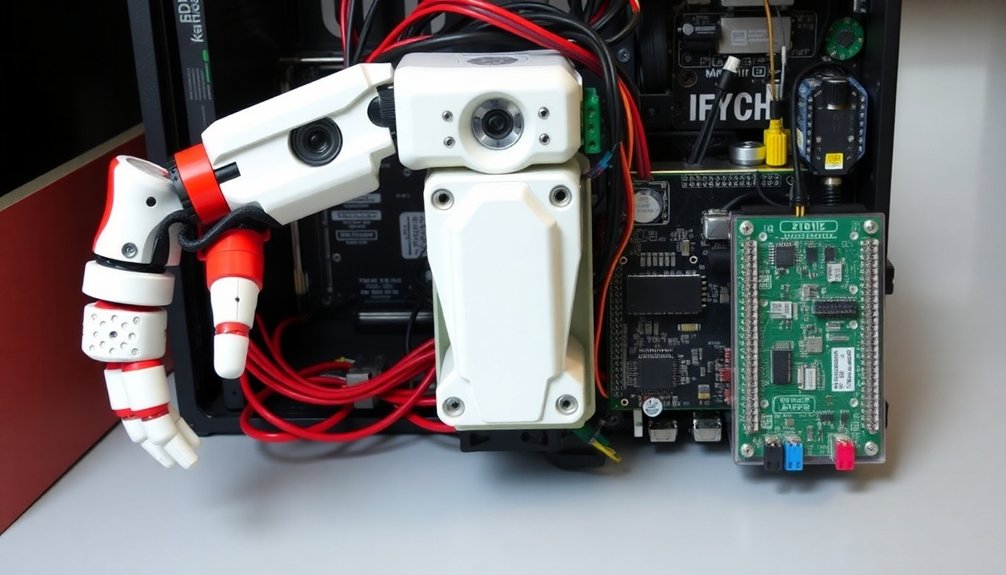
The future of robotics isn’t about picking one software playground—it’s about making different tech speak the same language.
We’re diving into hybrid system integration, where modular AI components dance together like perfectly choreographed robot partners.
- Hybrid approaches transform rigid systems into flexible, intelligent platforms
- Custom AI frameworks + ROS = robot superpowers released
- Modularity isn’t just a buzzword—it’s how we build smarter machines
People Also Ask
How Difficult Is It to Learn ROS for Beginners in Robotics?
We find ROS challenging for beginners due to its steep learning curves. With solid tutorials and practice, we’ll navigate beginner resources effectively and build our robotics programming skills.
Can Humanoid Robots Built With ROS Match Custom AI Platform Performance?
We’ve investigated performance benchmarks, finding ROS-based humanoid robots can indeed match custom AI platforms by strategically leveraging modular architecture, community-driven optimizations, and sophisticated robot capabilities through intelligent integration techniques.
What Are the Security Implications of Using Open-Source Robotic Platforms?
We face significant security challenges with open-source robotic platforms. Our vulnerabilities include unauthorized access and code injection risks, which demand continuous security updates to mitigate potential cyber threats.
How Expensive Is Developing a Humanoid Robot With ROS?
Like building a complex LEGO set, developing a humanoid robot with ROS ranges from $30,000 to $150,000, with cost factors and development timeline influenced by component complexity, customization needs, and integration challenges.
Will Custom AI Platforms Eventually Replace ROS in Robotics?
We don’t think custom AI platforms will replace ROS, as industry trends favor platform flexibility and ROS’s development efficiency outpaces narrow custom solutions across collaborative robotics domains.
The Bottom Line
We’ve navigated the complex landscape of robotic operating systems, revealing that the future isn’t about choosing between ROS and custom platforms—it’s about intelligent integration. Like master chefs mixing secret ingredients, the most innovative robotics will blend open-source flexibility with specialized AI architectures. Are we building tools or creating digital companions? The answer lies in continuous adaptation, where technology becomes less about systems and more about human-machine collaboration.
References
- https://www.ros.org
- https://developer.nvidia.com/isaac/ros
- https://www.toptal.com/robotics/introduction-to-robot-operating-system
- https://www.hotbot.com/articles/robotics-operating-system-key-features-and-practical-applications/
- https://www.theconstruct.ai/history-ros/
- https://ifr.org/robot-history
- https://aventine.org/robotics/history-of-robotics
- https://www.uti.edu/blog/robotics-and-automation/the-definitive-timeline-of-robotics-history
- https://www.cs2n.org/u/mp/badge_pages/3574
- https://discourse.ros.org/t/guidelines-on-how-to-architect-ros-based-systems/12641

